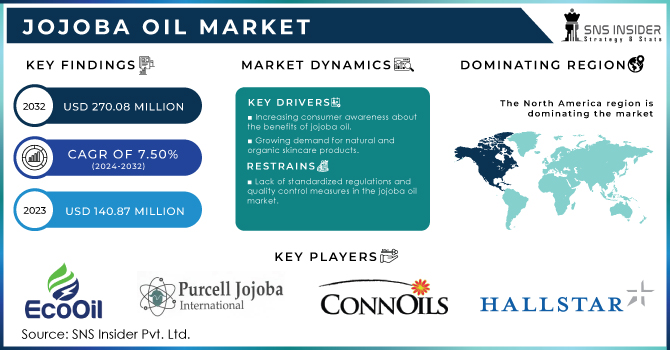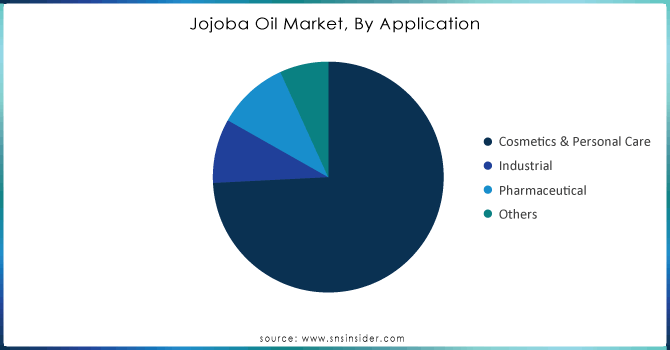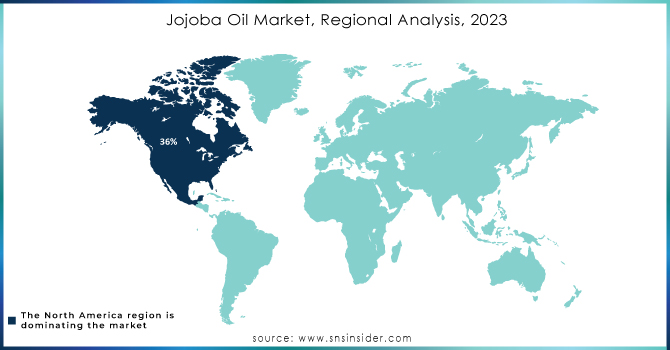Jojoba Oil Market Report Scope & Overview:

Get E-PDF Sample Report on Jojoba Oil Market - Request Sample Report
The Jojoba Oil Market size was valued at USD 140.87 million in 2023. It is estimated to hit USD 270.08 million by 2032 and grow at a CAGR of 7.50% over the forecast period of 2024-2032.
Jojoba oil, derived from the seeds of the jojoba plant, is renowned for its exceptional properties and wide range of uses. With its natural composition resembling human sebum, jojoba oil has gained popularity in the cosmetics and personal care industry. Additionally, its applications extend to pharmaceuticals, industrial lubricants, and various other sectors. The rising consumer inclination towards natural and organic products, coupled with the expanding awareness of the benefits of jojoba oil, is expected to drive market growth. Additionally, the growing popularity of sustainable practices and the shift towards eco-friendly alternatives will further contribute to the market's expansion.
The main factor for this rise is the growing personal care and cosmetic preferences of today’s consumers. As one of the most popular non-comedogenic and intensely moisturizing oils, jojoba oil is not an exception to the consumer trends.
Another significant factor that shows the growth of the market is the recent industry events. For example, one of the major players in the jojoba oil market Noble Extraction revealed a new line of oil that is sustainably sourced. Altogether, the growing trend for the eco-conscious lifestyle and the increase of awareness regarding natural high-value oils have spurred the growth of the market.
The fact that it is one of the most effective solutions for strengthening the hair and enhancing its gloss is truly observed by the customers. Additionally, it is known for its positive influence on the scalp, and this oil is now used in shampoos, hair conditioners, and serums. The significant point that contributed to this trend was the release of John Masters Organics’ new line of hair care products that contained organic jojoba oil among the major ingredients. It should be noted that although the product is aimed at highlighting that this oil helps to nourish and moisturize the hair, the fact that the producer draws attention to the use of organic matter plays a significant role in advancing this trend.
For instance, in 2023 when John Masters Organics launched a new line of hair care products featuring organic jojoba oil as a key ingredient. This product line not only emphasizes the nourishing and moisturizing benefits of jojoba oil but also highlights the brand's commitment to using organic materials.
Jojoba Oil Market Dynamics
Drivers
-
Increasing consumer awareness about the benefits of jojoba oil.
-
Rising popularity of jojoba oil as a versatile ingredient in various industries
-
Growing demand for natural and organic skincare products
In recent years, there has been a notable shift in consumer preferences towards products that are derived from natural sources and free from harmful chemicals. This trend is particularly evident in the skincare industry, where individuals are becoming more conscious of the potential adverse effects of synthetic ingredients on their skin and overall well-being. Unlike many conventional skincare products, jojoba oil is renowned for its natural composition, making it a safe and gentle option for various skin types. It possesses exceptional moisturizing qualities, effectively hydrating the skin without leaving a greasy residue. Additionally, jojoba oil is rich in vitamins and antioxidants, which contribute to its ability to nourish and rejuvenate the skin. As consumers become more educated about the potential risks associated with synthetic skincare ingredients, they are actively seeking natural alternatives. The rise in awareness regarding the benefits of jojoba oil has led to an increased demand for products that contain this versatile ingredient. Consequently, the jojoba oil market is experiencing substantial growth as skincare enthusiasts embrace the natural and organic movement.
Restrain
-
Fluctuating prices of jojoba oil due to factors like weather conditions and market demand
-
Lack of standardized regulations and quality control measures in the jojoba oil market
-
Limited availability of jojoba oil due to its specific cultivation requirements
Jojoba oil, derived from the seeds of the jojoba plant, has gained immense popularity in various industries due to its numerous benefits. However, the cultivation of jojoba plants is not without its limitations. These plants thrive in specific climatic conditions, requiring arid regions with well-drained soil and a moderate temperature range. Consequently, the cultivation of jojoba plants is restricted to certain geographical areas, primarily found in regions such as the southwestern United States, Mexico, and parts of South America. Furthermore, the cultivation of jojoba plants is a time-consuming process. These plants take several years to mature and produce seeds suitable for oil extraction. This slow growth rate further exacerbates the scarcity of jojoba oil in the market.
Opportunities
-
Expanding applications of jojoba oil in the cosmetics, pharmaceutical, and food industries.
-
Increasing research and development activities to explore new uses and benefits of jojoba oil.
Jojoba Oil Market Segmentation Overview
By Type
Cold-pressed type held the highest revenue share of 64.5% in 2023. Cold-pressed jojoba oil is defined as the oil extracted from jojoba seeds using pressure. This technique does not require the use of heat or chemicals and, therefore, retains the oil’s natural nutrients, i.e. vitamins, antioxidants, and essential fatty acids. The cold extraction technique is especially valued in the cosmetics, skincare, and pharmaceutical development industries where product purity is crucial. Cold-pressed jojoba oil is valued for its moisturizing, anti-inflammatory, and anti-aging properties, and is a popular ingredient in premium beauty and personal care products. The rapidly growing preference for natural and chemical-free products among consumers also contributes to its popularity. Although the cold-pressing technique is considered a premium option due to the price, the high quality justifies it and results in high revenue.
By Sales Channel
B2B was the leading channel in the global market, and the highest revenue share was 62.4% in 2023. On the sales side, B2B marketing assists clerks and traders in developing a foundation for interactions with businesses that can use the company’s products or services. Given the complexity and difficulty of identifying leads, lead generation may prove challenging. As a result, it is best to use lead lists provided by reputable third-party providers. Since Internet sales of jojoba oil are at an all-time high, there is a growing demand for B2B sellers to create an online sales strategy. A user-friendly website is at the heart of all of the online sales and marketing efforts. It would also be beneficial to incorporate email marketing as well as search engine, social network, and mobile strategies into your sales plan and marketing mix.
By Application
The cosmetics & personal care applications segment dominated the jojoba oil market with the highest revenue share of about 74.2% in 2023. This dominance is attributed to the escalating demand for products sourced naturally and organically. The regular utilization of hair care products infused with jojoba oil has proven to be highly effective in combating hair fall, while simultaneously enhancing hair thickness, texture, and overall quality. Furthermore, it serves as a valuable remedy for dry, itchy scalps and split ends. Beyond its hair care benefits, jojoba oil finds extensive usage in various cosmetic formulations, including lipsticks, makeup removers, lip balms, and nail polish. Its versatility and efficacy make it an indispensable ingredient in the creation of these beauty products.

Get Customized Report as Per Your Business Requirement - Request For Customized Report
Jojoba Oil Market Regional Analysis
North America dominated the jojoba oil market with the highest revenue share of about 36% in 2023. The region boasts a favorable climate and geographical conditions that are conducive to the cultivation of jojoba plants. This has facilitated the establishment of numerous jojoba oil production facilities, ensuring a steady supply of this valuable commodity. Additionally, North America has witnessed a surge in consumer awareness and demand for natural and organic products, including jojoba oil. The region's population has become increasingly conscious of the benefits offered by jojoba oil in skincare, haircare, and other personal care applications. This heightened awareness has translated into a significant increase in the consumption of jojoba oil, thereby driving its market share to new heights.
Asia Pacific is expected to grow with the highest CAGR of about 7.9% in the jojoba oil market during the forecast period. The Asia Pacific region has the presence of the largest cosmetics and personal care markets worldwide, including South Korea, Japan, India, and China. Among these, the Korean skincare and cosmetics industry stands out as a developed and highly competitive market, characterized by fragmentation. In this dynamic landscape, brands continuously invest in research and development activities to create innovative products. Beauty holds significant cultural importance in South Korea, leading consumers to possess extensive knowledge about cosmetics and maintain exceptionally high standards. Consequently, cosmetics companies face immense pressure to deliver products that are both innovative and of exceptional quality to meet these elevated expectations. The changing lifestyle with increased adoption of cosmetic products in this region drive growth of the jojoba oil market in the coming years.

Key Players in Jojoba Oil Market
-
Ecooil (Eco Jojoba Oil)
-
Purcell Jojoba (Pure Jojoba Oil)
-
ConnOils LLC (Jojoba Oil 100%)
-
Inca Oil SA (Inca Jojoba Oil)
-
JD Jojoba Desert (Desert Jojoba Oil)
-
Jojoba Naturals (Jojoba Skin Oil)
-
Nutrix International LLC (Nutrix Jojoba Oil)
-
OPW Ingredients GmbH (OPW Jojoba Oil)
-
US Organic Group Corp, (Organic Jojoba Oil)
-
Hallstar (Hallstar Jojoba Oil)
-
Desert Whale Jojoba Company (Jojoba Oil)
-
The Jojoba Company (Australian Jojoba Oil)
-
A&A Fratelli Parodi (Jojoba Oil Fragrance)
-
Jojoba Desert (Pure Jojoba Oil)
-
Organic Jojoba Oil Company (Certified Organic Jojoba Oil)
-
Forever Living Products (Forever Jojoba Oil)
-
Noble Extraction (Noble Jojoba Oil)
-
Jojoba Valley (Golden Jojoba Oil)
-
Eden Botanicals (Jojoba Oil Refined)
-
Botanic Innovations (Jojoba Oil Blend)
Recent Development:
-
In 2023, Ecooil launched a new line of organic jojoba oil products aimed at enhancing sustainability in the cosmetics industry.
-
In2023, Purcell Jojoba expanded its product offerings by introducing a refined jojoba oil specifically designed for cosmetic formulations, enhancing its versatility.
-
In 2023, ConnOils LLC Introduced a premium grade of jojoba oil targeting the personal care and cosmetic sectors, emphasizing its moisturizing properties.
| Report Attributes | Details |
| Market Size in 2023 | US$ 140.87 Million |
| Market Size by 2032 | US$ 270.08 Million |
| CAGR | CAGR of 7.5% From 2024 to 2032 |
| Base Year | 2023 |
| Forecast Period | 2024-2032 |
| Historical Data | 2020-2022 |
| Report Scope & Coverage | Market Size, Segments Analysis, Competitive Landscape, Regional Analysis, DROC & SWOT Analysis, Forecast Outlook |
| Key Segments | • By Grade (Lite Jojoba (Bleached Jojoba) and Winterized) • By Type (Refined and Cold-Pressed) • By Sales Channel (B2C and B2B) • By Application (Cosmetics & Personal Care, Industrial, Pharmaceutical, and Others) |
| Regional Analysis/Coverage | North America (US, Canada, Mexico), Europe (Eastern Europe [Poland, Romania, Hungary, Turkey, Rest of Eastern Europe] Western Europe] Germany, France, UK, Italy, Spain, Netherlands, Switzerland, Austria, Rest of Western Europe]), Asia Pacific (China, India, Japan, South Korea, Vietnam, Singapore, Australia, Rest of Asia Pacific), Middle East & Africa (Middle East [UAE, Egypt, Saudi Arabia, Qatar, Rest of Middle East], Africa [Nigeria, South Africa, Rest of Africa], Latin America (Brazil, Argentina, Colombia Rest of Latin America) |
| Company Profiles | Ecooil, Purcell Jojoba, ConnOils LLC, Inca Oil SA, JD Jojoba Desert, Jojoba Naturals, Nutrix International LLC, OPW Ingredients GmbH, US Organic Group Corp, Hallstar |
| Key Drivers | • Increasing consumer awareness about the benefits of jojoba oil. • Rising popularity of jojoba oil as a versatile ingredient in various industries • Growing demand for natural and organic skincare products |
| Market Restraints | • Fluctuating prices of jojoba oil due to factors like weather conditions and market demand • Lack of standardized regulations and quality control measures in the jojoba oil market • Limited availability of jojoba oil due to its specific cultivation requirements |

